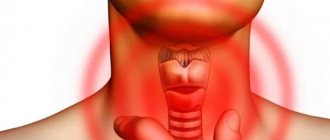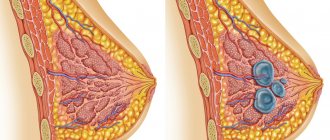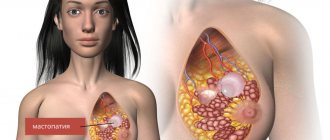Causes of hyperestrogenism
Female sex hormones are synthesized by various organs: this function in women is mainly assigned to the ovaries, but some of them are produced by the adrenal glands and adipose tissue. Hormonal imbalance, in which an excessive concentration of estrogen is found in the blood, can be caused by various factors, which are divided into primary and secondary.
The primary causes of hyperestrogenism are directly related to the increased production of female sex hormones, which may be due to the following pathologies:
- hormone-producing ovarian tumors, which are usually benign;
- neoplasms in the pituitary-hypothalamus system, in which an increased amount of estrogen or FSH enters the blood;
- tumors in the adrenal glands of various etiologies;
- malignant tumor in the uterus - chorionepithelioma.
Hyperestrogenism can be caused by factors not directly related to excessive estrogen synthesis; in this case, they speak of secondary causes of changes in hormonal levels:
- The use of oral hormonal drugs as methods of contraception, when their choice was made by the woman independently without consulting a doctor or conducting hormonal screening.
- Obesity and metabolic syndrome, which result in excess production of estrogen by fat cells.
- Serious liver pathologies, such as cirrhosis and viral hepatitis, in which cytolysis syndrome appears. These changes often occur against the background of chronic alcoholism. With such diseases, estrogens cannot be eliminated from the body in sufficient quantities, and they accumulate in the blood, which causes hormonal imbalance.
In addition, unhealthy lifestyle, unbalanced diet, lack of physical activity, and uncontrolled use of certain medications can lead to hyperestrogenism.
We recommend reading about secondary amenorrhea. You will learn about the causes of secondary amenorrhea in women and adolescents, types of amenorrhea and their characteristics, diagnosis and treatment. And here is more information about the treatment of algodismenorrhea.
Risk factors
The likelihood of developing hyperestrogenism in women is associated with the presence of chronic diseases, poor heredity, or reluctance to consult a gynecologist about methods of preventing unwanted pregnancy.
The main risk factors for the disease include:
- the use of intrauterine devices as a means of contraception without their periodic replacement and examination by a gynecologist;
- unhealthy eating behavior, excess weight;
- the presence of problems with the functioning of the endocrine system - diabetes, thyroid diseases and others;
- hereditary predisposition, the presence of similar problems in the mother, sister or other close relatives on the female side.
Overweight
Forecast
In the initial stage of hyperestrogenism, when there are no complications yet, the prognosis of the disease is favorable. Elimination of negative environmental factors and adequate treatment can completely restore body functions.
With prolonged exposure to high levels of estrogen, the risk of malignant proliferative processes increases. The outcome of the disease in this case depends on the stage of the tumor and the general condition of the body. Hyperestrogenism in women is less common than deficiency of sex hormones.
However, this disease can lead to serious complications. Subjective symptoms of the disease can easily be confused with other conditions, so to make an accurate diagnosis and identify the cause, you need to see a doctor and take blood tests to determine hormone levels. In order to prevent hyperestrogenism, women need to avoid the risk factors listed above.
Symptoms in women
Signs of the disease can manifest themselves differently, depending on the degree of hormonal imbalance, therefore in medical practice there is a distinction between absolute and relative hyperestrogenism. Their differences lie in the causes of the pathology: in the absolute form, clinical symptoms are caused by a systemic disease that provokes increased synthesis of female sex hormones.
With relative hyperestrogenism, symptoms appear not due to an increase in estrogen concentration, but due to a decrease in progesterone synthesis.
The main symptoms of the pathology include:
- Weight gain not associated with eating disorders. Women often complain that they lead an active lifestyle, follow a low-calorie diet, and their weight continues to increase, with fat being deposited mainly in the thighs.
- Changes in the nature of the menstrual cycle. If a woman experiences heavy bleeding during her menstrual periods, or the interval between them changes, this most likely indicates an increase in estrogen levels.
- Increased sensitivity of the mammary glands. If breast enlargement and increased sensitivity during menstruation are considered normal, then such changes not related to the cycle are most often a symptom of hyperestrogenism. Also, persistent pain in the mammary glands may indicate problems with hormones.
- Changes in psycho-emotional state. An increased level of estrogen leads to excessive irritability, causeless tearfulness, a tendency to depression, susceptibility to panic attacks and sudden mood swings.
- Frequent headaches and migraines.
- Complaints about hair loss.
- Problems with concentration and memory.
- Sleep disorders, insomnia.
- General weakness of the body, decreased performance, fatigue.
In addition, with elevated estrogen levels, women are often diagnosed with hypertension, endometriosis, and the appearance of tumors in the mammary glands, ovaries and uterus.
High levels of estrogen in the body
An increase in estrogen makes itself felt by the following symptoms:
- headaches, migraines, dizziness;
- sleep disturbance;
- nausea, vomiting;
- nervousness, irritability;
- swelling;
- indigestion, bloating;
- increased blood pressure;
- disruption of the menstrual cycle;
- increase in body weight;
- fatigue;
- cold hands and feet;
- acne on the skin;
- hair loss;
- tendency to thrombosis;
- formation of tumors (in the uterus, mammary glands)
Possible complications
The most dangerous consequence of accelerated estrogen synthesis is endometrial hyperplasia, which threatens a woman with frequent and heavy bleeding. In addition, due to prolonged hyperestrogenism, fibroids may begin to develop in the uterus.
Also, without timely and adequate treatment, the disease can lead to the following complications:
- the development of osteoporosis - a condition in which bones lose strength, and even minimal load can cause a fracture;
- sudden weight gain and rapid gain of fat mass;
- painful cramps in the calf muscles;
- deterioration of blood clotting, which can lead to the formation of blood clots and the development of varicose veins;
- infertility;
- problems with the regularity of the menstrual cycle.
Expert opinion
Daria Shirochina (obstetrician-gynecologist)
An increased concentration of estrogen can cause a painful condition in women, similar to the manifestations of menopause; they may complain of increased irritability, sweating, hot flashes to the face, and constant headaches. Treatment is normalization of hormonal levels. Only normalizing your weight can significantly improve your condition.
Diagnostic methods
Determining pathologies associated with increased synthesis of female sex hormones is fraught with some difficulties, since traditional tests cannot always reliably identify impaired hormone metabolism.
The main diagnostic method is hormonal screening, which must be carried out repeatedly in different phases of the menstrual cycle. During screening, the level of not only female sex hormones, but also the concentration of testosterone, progesterone, prolactin and others is determined in the blood serum.
Fluctuations in estrogen and progesterone levels during the cycle
Modern laboratory research techniques make it possible to check hormonal levels using a saliva sample. This simplified method of taking material for analysis makes it possible to determine the hormonal balance not only in the follicular and luteal phases of the cycle, but also on other days. However, in Russia such diagnostics are not widely used.
Elevated estrogen levels can be determined by a blood test: if the results reveal a high concentration of fibrinogen and sex hormone binding proteins, a diagnosis of hyperestrogenism can be made.
If a girl during puberty presents with problems, the doctor should pay increased attention to collecting an anamnesis, during which it is necessary to find out the time of the onset of menstruation, the regularity and duration of the cycle, and the intensity of bleeding during menstrual periods.
If the main complaint is excessive bleeding during menstruation, it is possible with a high degree of certainty to assume endometrial hyperplasia, which occurs due to increased synthesis of estriol. At the same time, girls often experience short stature, earlier development of secondary sexual characteristics, an abundance of body hair, and premature ossification.
In adult women, the diagnosis can only be confirmed after a comprehensive examination. In addition to hormonal screening, the doctor needs to obtain reliable data on the condition and thickness of the endometrium. If a transvaginal ultrasound examination reveals endometrial hyperplasia, and a delay in ovulation is noted, then we can confidently speak about hyperestrogenism.
About the functions of estrogen in the female body, watch this video:
How to check estrogen levels in the body
To determine estrogen levels, a woman needs to donate blood from a vein on an empty stomach.
- If the cycle lasts from 20 to 28 days, blood is donated on days 2-3;
- With a standard cycle of 28-29 days, the test is taken on days 2-5 of the cycle;
- If the cycle is longer, then blood is donated on days 5-7.
Finally, I would like to warn women who are trying to maintain youth with the help of face and breast creams with hormones. The creams contain plant hormones; high-quality products are quite capable of producing the expected effect, but they must be used very carefully, after consultation with a doctor.
Treatment of hyperestrogenism
Therapeutic tactics depend on the reasons that caused the increase in the level of female sex hormones in the blood. If primary absolute hyperestrogenism is diagnosed, then treatment should be carried out in a comprehensive manner with possible surgical removal of tumors in the ovaries or adrenal glands.
In case of secondary pathology, before carrying out hormonal therapy, it is necessary to eliminate the causes of the disease: normalize eating behavior, stop taking oral contraceptives, eliminate factors that negatively affect liver function.
| Drugs that regulate a woman’s hormonal balance | |
| Tamoxifen | The drug is taken in long courses. The main pharmacological effect is to reduce the concentration of female sex hormones and prevent the growth of tumors in the mammary glands. It is prescribed with caution for existing problems with the gastrointestinal tract, since it has a resolving effect on the gastric mucosa and provokes the formation of ulcers and gastritis. |
| Indinol | It has proven itself well as a means of allowing, in combination with other drugs, to normalize the process of estrogen synthesis and prevent the development of hormone-producing tumors in the ovaries and uterus. The course of treatment is long, can last up to six months. |
| Mastodion | Prescribed for severe premenstrual syndrome, normalizes hormonal levels. |
| Yarina | A hormonal oral contraceptive, which in case of hyperestrogenism is prescribed to reduce estrogen levels and regulate the menstrual cycle. Indicated for the prevention of the development of malignant ovarian tumors. |
In addition to these medications, the course of treatment, if necessary, includes the following therapeutic measures:
- treatment of gastrointestinal pathologies and elimination of problems with liver function;
- normalization of insulin levels in the blood, which is achieved through drug therapy and a special diet;
- transition to a balanced diet and healthy lifestyle;
- prescription of progesterone analogues (gestagens), androgens.
Among the gestagens, the most popular among doctors are the drugs Duphaston and Progestogel.
The course of complex therapy can also use folk recipes based on medicinal herbs - yarrow, angelica, red brush and others.
After completing the course of hormonal therapy, vitamin complexes are prescribed to stimulate follicle growth and increase endometrial activity. You can also use individual vitamins, for example, B1 and B6, injections of which can be alternated every other day.
Also, physiotherapeutic methods have proven themselves well as restorative therapy: magnetotherapy, mud therapy, sanatorium treatment at balneological resorts.
If the cause of increased estrogen synthesis is an ovarian tumor, surgical removal is indicated. Since such neoplasms are usually benign, it is sufficient to perform an ovarian resection, or adnexectomy.
How to reduce estrogen levels
The following will help lower estrogen levels:
- balanced nutrition with environmentally friendly products;
- predominance of fiber in the diet;
- flax seeds, sesame seeds, sage, sprouted wheat grains, cereals;
- foods containing sulfur - onions, garlic, egg yolks, green leafy vegetables, citrus fruits;
- cruciferous vegetables - cabbage, turnips, turnips, rutabaga;
- mushrooms;
- green tea;
- grenades;
- vitamin complexes;
- reducing the share of alcoholic beverages;
- refusal of red meat and fatty dairy products, fats, baked goods, sweets;
- physical exercise;
- healthy, full sleep;
- careful handling of household chemicals;
- mental balance
Before reducing or increasing the level of hormones, you should find out their content in the body.
Prevention methods
To prevent hormonal problems, a woman should definitely consult a doctor about the possible use of oral contraceptives and under no circumstances choose them on her own. In addition, it is necessary to monitor the nature and regularity of the menstrual cycle and contact a gynecologist at the first signs of pathology.
We recommend reading about ovarian wasting syndrome. You will learn about the causes of premature ovarian failure, symptoms of the syndrome, its diagnosis and treatment.
And here is more information about ovarian dysfunction.
Hyperestrogenism requires a careful approach to diagnosis and treatment, since it can be caused by various systemic disorders. With proper and timely therapy, a woman can fully recover and improve her quality of life.
Useful video
About female sex hormones, watch this video:
Similar articles
- Ovarian depletion syndrome: the main causes...
Ovarian depletion syndrome is determined even in very young girls. The reasons may lie in heredity and hormonal disorders. Sometimes called early menopause, although premature ovarian failure is not quite that. It is impossible to get pregnant without treatment; sometimes only IVF can save you. Read more - Ovarian dysfunction: signs, causes...
Ovarian dysfunction occurs at absolutely any age - in adolescents, in the reproductive age, there is menopause. The reasons can be natural, internal, external. Treatment is long-term; success depends on timely consultation with a doctor. Read more
- Dysfunctional uterine bleeding: causes...
Dysfunctional uterine bleeding is quite dangerous. The reasons will differ in the reproductive and premenopausal periods. There is a special classification that takes into account many factors. For example, ovulatory and juvenile DMCs are isolated. Sometimes you need emergency help and treatment Read more
- Algodismenorrhea: treatment, causes of primary...
If algodismenorrhea is detected in girls, treatment should be started as soon as possible. It can be primary and secondary, adolescents are often diagnosed with “NMC syndrome by type”, and women – secondary. Symptoms: acute pain during menstruation, changes in emotional background. Medicines, pills, exercise therapy will help. Read more











